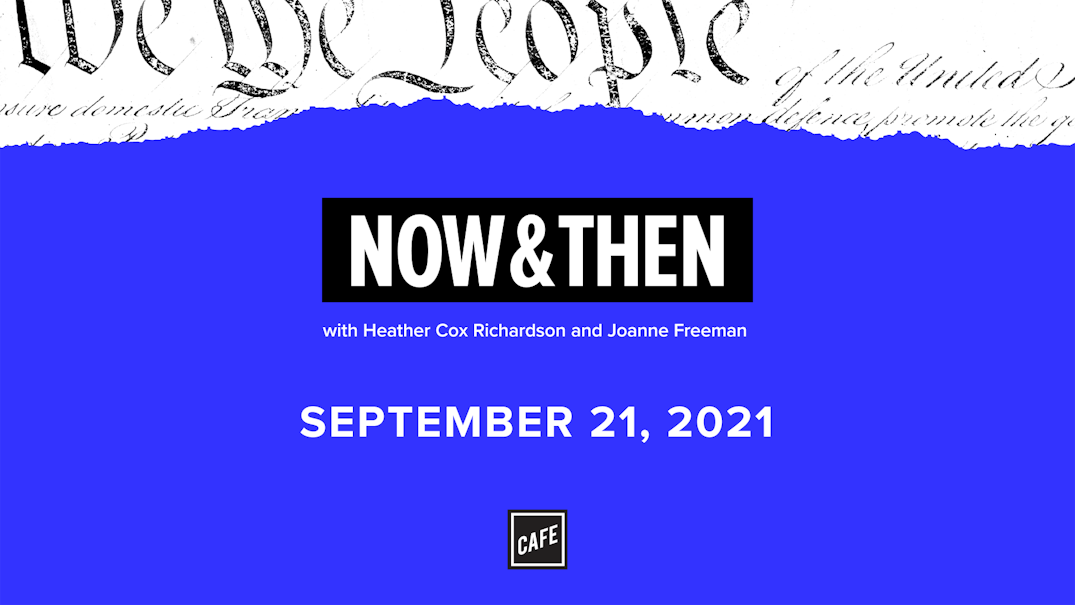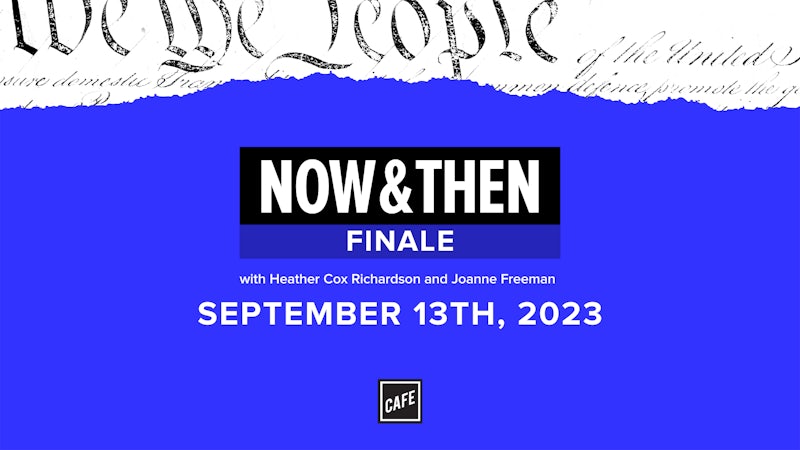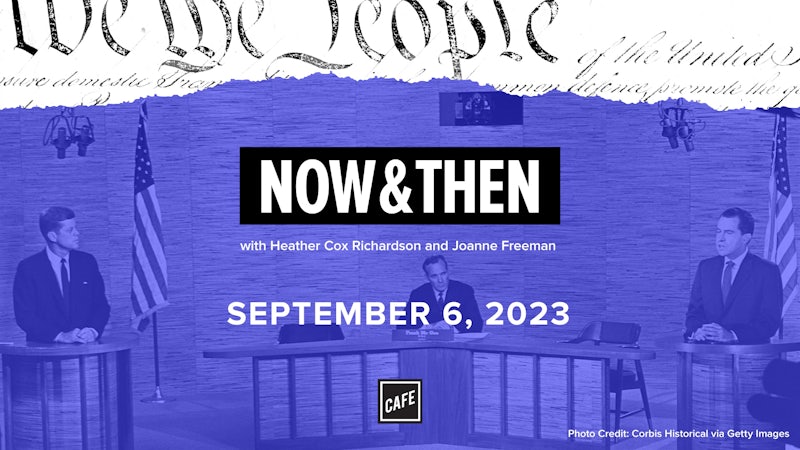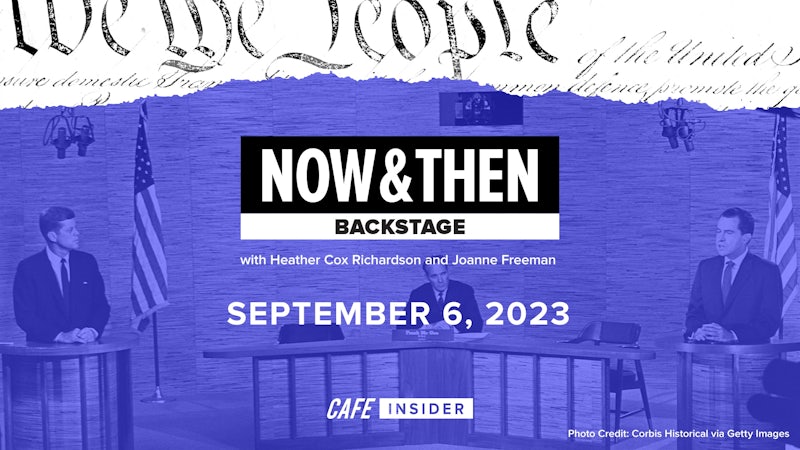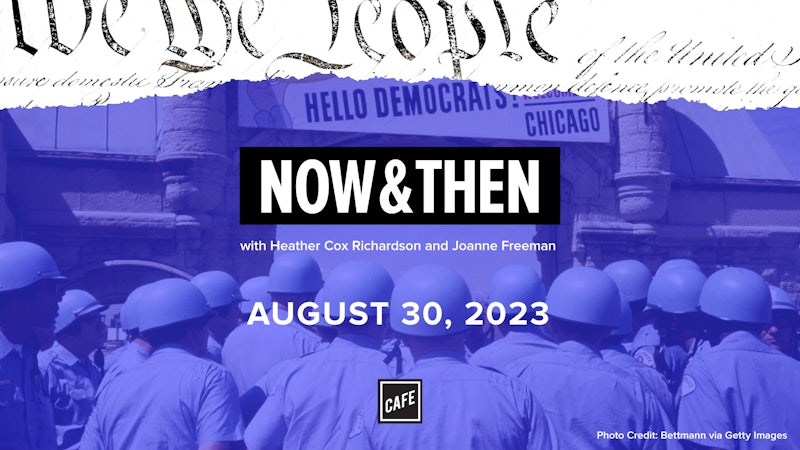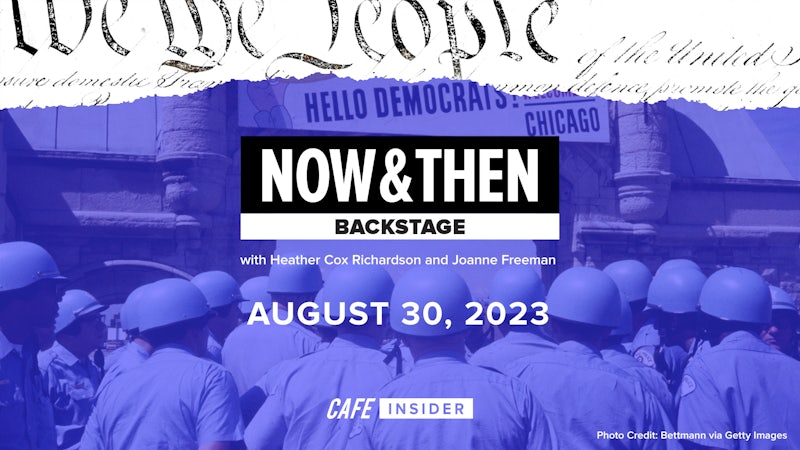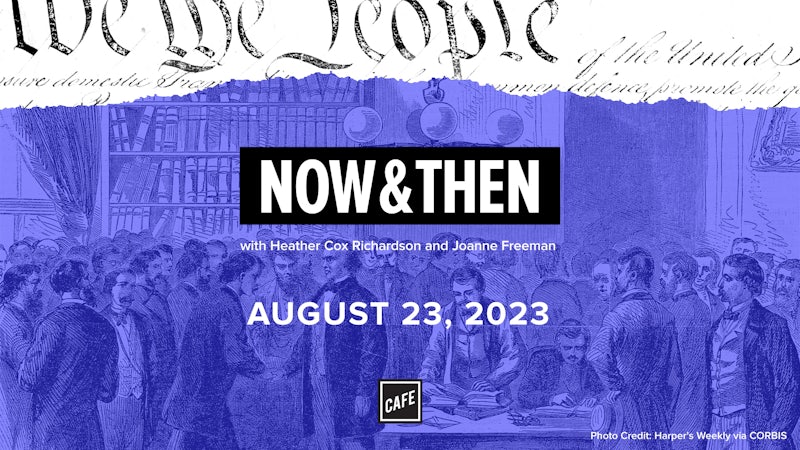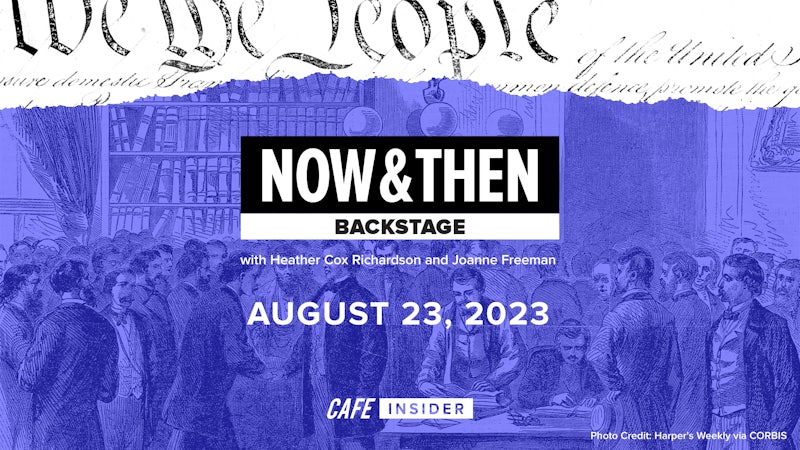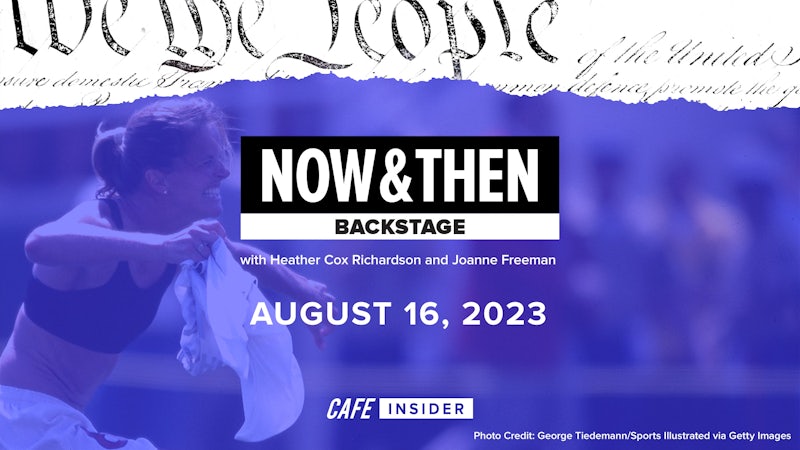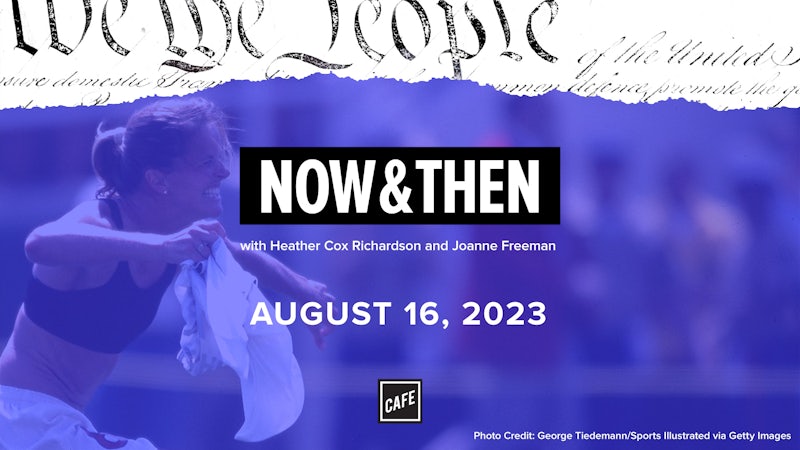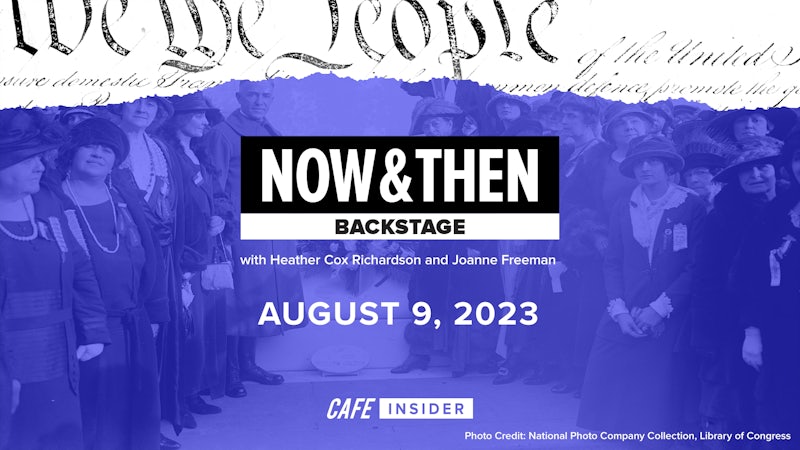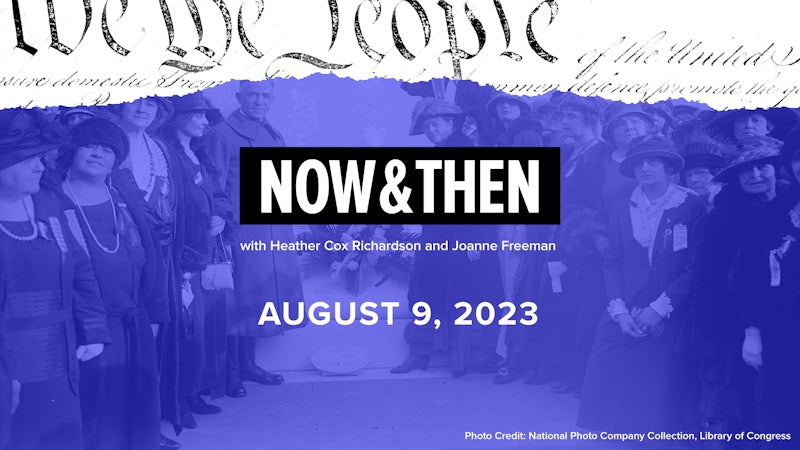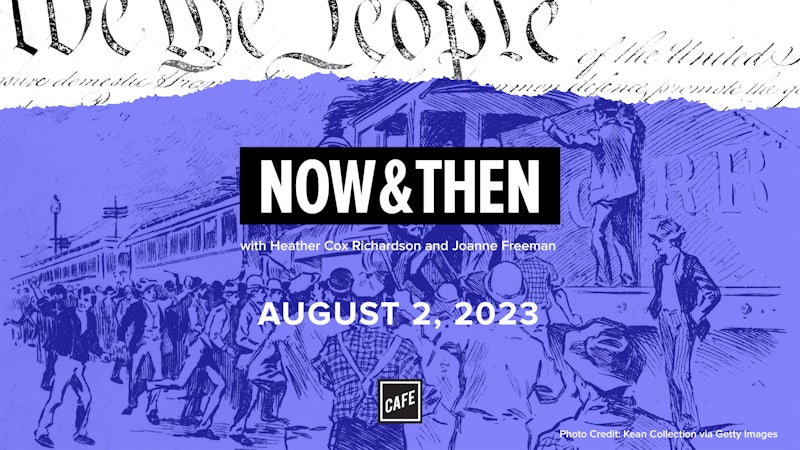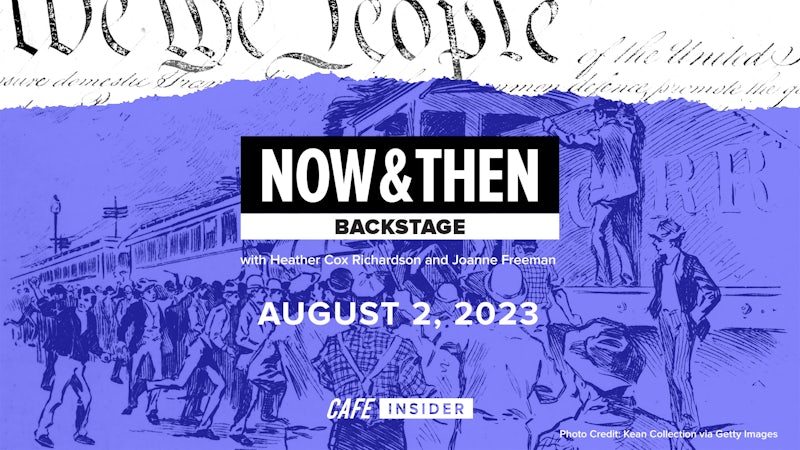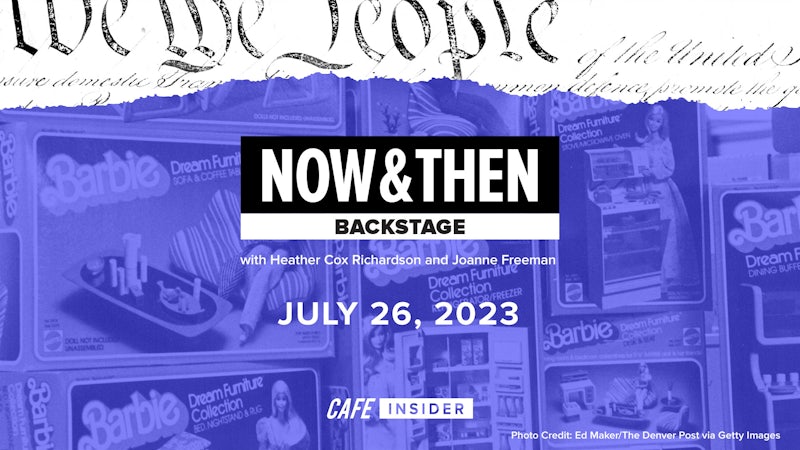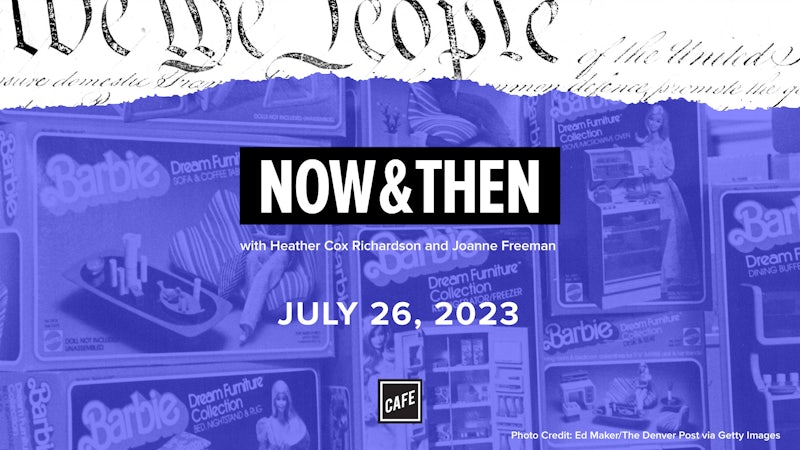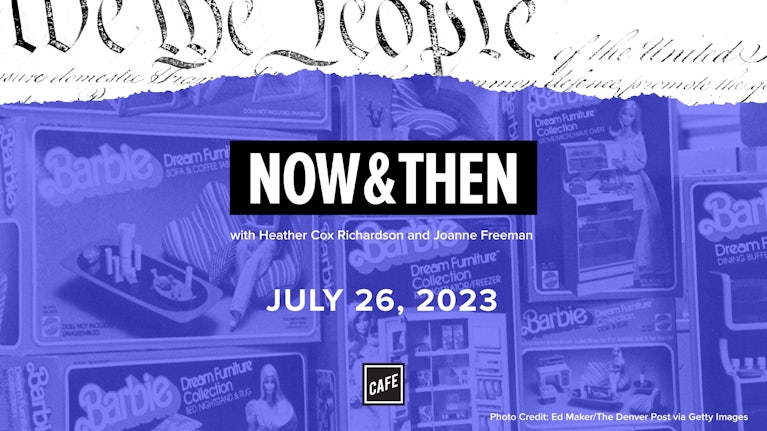Heather Cox Richardson:
From CAFE and the Vox Media Podcast Network, this is Now & Then. I’m Heather Cox Richardson.
Joanne Freeman:
And I’m Joanne Freeman. Today we want to talk to you about a topic that grew out of something that of course has been in the news recently but launched us in a direction that we didn’t necessarily expect at first. So obviously September 11th and what happened on that day in 2001 and the commemoration of it that happened recently and the discussion of it being 20 years past when it happened has been filling newspapers and filling media of all kinds, there’s been a lot of discussion of it. But when we were discussing what we wanted to talk about this week, we thought one of the interesting things about the way in which we’ve processed September 11th and any number of other things in American culture is there’s a New Yorkness to them, there’s a way in which the fact that they take place in New York really shapes the way that we understand them, and that says a lot, the way we talk about New York says a lot about the way we think about America.
Heather Cox Richardson:
So when we’re thinking about how to approach the issue of 9/11, we were really curious about the way in which it would be commemorated because just to go quickly over what happened on that day, 19 men hijacked four U.S. commercial airplanes. They were airplanes that were bound for the West Coast, so were carrying a lot of jet fuel. They flew those planes into the Twin Towers in New York, into the Pentagon, and the passengers on the fourth plane crashed it in Shanksville, Pennsylvania. And a total of close to 3,000 people, about 2977 people were killed in those attacks. And of course we just hit the 20th anniversary of those attacks, but what’s interesting to us when we were talking about this was thinking about the ways in which we commemorated the 20th anniversary and what really jumped out to me when we talked about 9/11 on the 20th anniversary was the degree to which people celebrated the ordinary people who helped each other, who stepped up like the kid in the red bandana who pulled people out of the buildings and strangers helping each other on the streets. And that’s what people talked about a lot.
And as we were talking about it, what jumped out to me when we were noticing this was the fact that, you’re going to hear how little I actually know about things like films, that’s Joanne’s field, but I do know a bit about comics. And what was really interesting about 9/11 itself was the fact that it creates a crisis in the American comic book industry, in a sense, because of course so many of the comic book heroes are from Gotham, they’re from New York and they’re supposed to save the city and they couldn’t save the city. Right after 9/11 in November of 2001 Marvel released a volume of The Amazing Spider-Man comics. It was a direct response to the attacks. The cover is black but the plot line is that the heroes are not the superheroes, the heroes are ordinary Americans, and that speaks so much to what New York means to so many people.
Joanne Freeman:
And the superheroes were bearing witness, that’s what that comic book was about, was that they were standing back and they themselves were acknowledging that it’s the ordinary people who were the heroes really of 9/11. So what we want to talk about today in a variety of different ways is what does that say about us? The way we look at New York, it’s almost a cliche to say, “Storied on stage and film.” It’s an epic kind of iconic part of American culture. It shapes our understanding of our history. We talk about it in extremes very often. It kind of almost has a mythic standing in some ways, particularly for those working in the realm of culture, for writers, for artists. What does that mean? What do people, when they’re talking about New York or showing New York or depicting it in one way or another, what does that say about what they’re suggesting, not just about the city, but about the United States?
Heather Cox Richardson:
Yeah, why New York? I mean, it’s funny when you think about teaching, for example, Colonial America, we often focus on New England or on Virginia, and yet there’s an argument to be made that it’s actually New York that’s the heart of the American Colonial experience.
Joanne Freeman:
New Yorkers would have said that for sure. From the very beginning.
Heather Cox Richardson:
Well, why though?
Joanne Freeman:
I mean, I think there’s a lot of reasons. I think one of them has to do with, I know what you’d like to talk a little bit about, and that has to do with the roots of New York and the fact that, in some ways, from its very beginning, it was a place that was grounded on diversity. As you and I have talked about any number of occasions, right? Seaport, port cities, that was part of what made a city important in this early period, but New York was initially very important, Philadelphia was initially very important, Boston, Richmond, Charleston, South Carolina. There were certain key cities that from a very early point were important, but New York always had a distinctive kind of a role.
Heather Cox Richardson:
Well in part because you think about places like Virginia and the Chesapeake, they were places that were deliberately designed around companies, around the idea of extracting resources and sort of rooted in mercantilism and the idea of pulling resources out of a colonial port and bring her out of a colonial area and bring them back to the mother country. And then of course you have New England, which is focused on religion and on establishing control over society through religion. And then you have New Amsterdam, which is settled by the Dutch and that ends up having a really different economy and a really different idea about what creates wealth for the mother country, if you will, and that’s trade. And because they’re not trying to impose necessarily an extract of economy on that region of the country and they’re not trying to impose a religion on that part of the country, they’re simply welcoming people who are willing to trade. There’s an argument to be made that that idea of sort of a multicultural trading center is what created the heart of America’s more successful impulses toward multiculturalism and tolerance.
Joanne Freeman:
And also if you think about it, and I’m sure we’re going to come back to this today, but if trade is at the heart of really what made New York standout at a very early point, that certainly will be the case for New York forever after, and in some ways that really is something that’s very typical of the engine, the fuel that makes America go, particularly in New York, finance, capitalism, money, trade.
Heather Cox Richardson:
And part of that of course is that the Dutch with their trading port there at New Amsterdam and on what is now Manhattan, which has this real mix of people coming in from all over, they end up trying to ward off the English. And this is one of my favorite stories about Colonial Manhattan because this is how we actually get the wall on which Wall Street is built. And the wall was actually constructed by the Dutch to keep out the English and they put a street along it on the inside or a road along it on the inside. And this is actually the origin for Wall Street. There really was a wall and it was actually an attempt of the Dutch to keep the British out. So New York has this phenomenal port, you’ve got ships coming and going from this port, you’ve got a lot of people, you’ve got a lot of trade and it becomes a sort of place that when people think about this colonial enterprise, they think about it, right?
Joanne Freeman:
Oh, absolutely. I mean, it really is. So when you take your oral exams in history as a graduate student, very often there’s some kind of a question about the major port cities, the most important cities in the United States in any given time. And it’s usually a safe bet to just stick New York in there as an answer because it truly was.
Heather Cox Richardson:
I never got that question. What else is in there?
Joanne Freeman:
The ones that you would expect some of them, not necessarily for the reasons that we think today, but absolutely some of the cities you would expect, Philadelphia and New York really being prime ones. So what’s interesting actually talking about Philadelphia and New York is that when the new nation begins, so when it kicks into gear in 1789 under the New Constitution, one of the early issues that they have to debate is where will the new capital of this new nation be? And that’s not a done deal. It’s not decided in any way. And of course, kind of along the lines of what we’ve already said about New York, Heather, New York assumes it’s going to be New York. Of course they do. And they assume, “Well, look at us, we’re a center of power or a center of finance, we’re a prosperous city, we have an international reputation, we are a center of culture, of course New York should be the new capital of the United States.” And it starts out that way. New York starts out as the first capital of the United States.
But part of the reason why New Yorkers are promoting it as being so wonderful or some of the reasons why people poke at it for being maybe less than ideal, because some people want America’s new capital city to be someplace representative of the new nation, not the old world with money and finance and everything else. They want a sort of lower key, they want a capital city that feels, they use this word a lot of the time, kind of medium in style, not extreme, not aristocratic, not rural, not low-key. A kind of middle of the road city that would be plain and common enough that it wouldn’t seem monarchical interest Socratic, but not so plain and common that it wouldn’t have some real oomph to it, cultural and political and commercial oomph. So Philadelphia ends up being the big contender.
Heather Cox Richardson:
I was going to say, so they end up with a swamp.
Joanne Freeman:
Well, the swamp is the third contender. Yeah, so they start out in New York.
Heather Cox Richardson:
That’s a great idea, let’s have a capital where nobody lives.
Joanne Freeman:
We’ll but that actually was the idea. They decided for the new country basically they were just going to build a new city. They create a new capital city. And when you look at the map, the early map of what comes to be Washington D.C., what you see is a very deliberately planned capital city with, for example, the presidential mansion and the capital at opposite ends of each other on a street. I mean, there’s very literal ways in which the map of Washington depicts constitutional power. So yeah, it ends up being in Washington after first being in New York, then being in Pennsylvania, it moves to Washington, and it is kind of a little bit rough and ready at the outset there in Washington.
Heather Cox Richardson:
But that speaks back to what you were talking about with New York. So they don’t want New York because you can imagine creating a new kind of government in a newly built city, but if in fact you go to this ancient city, if you will, for the colonies of New York, it’s already got established its financial system, its powerful families, its history, and you don’t necessarily want to impose that on the entire rest of the country. Is that the argument behind not staying in New York?
Joanne Freeman:
One of the arguments, yeah. And people pointed to Philadelphia with a kind of cultural angle. They dress a little plainer in Philadelphia, there’s more farmers in Pennsylvania, that New York has a sort of aristocratic wealthy tone to it that is not proper for what we want the new nation to be.
Heather Cox Richardson:
Okay. So if I’m a colonial American, do I recognize a New Yorker when I see him?
Joanne Freeman:
Well, here’s something that I have always found almost so comical that you would think it’s not true, except it is. When people, particularly in the First Congress, so people who are not from New York and they go to New York for that First Congress, and there’s a wonderful Pennsylvania Senator named William Maclay who has this amazing diary that includes everything in it, his dreams, toys he buys his kids. And one of the things he records in his diary are his thoughts about New York. And he refers in his diary to what he calls the “New York walk”. And the New York walk is basically New Yorkers walking very fast, kind of bent over at the waist because they want to be walking even faster than they’re walking. So the New York walk is fast and nothing gets in your way if you’re walking the New York walk. And New Yorkers talk very fast.
So basically these fast walking, fast talking sort of tough guy New Yorkers who as Maclay puts it in his diary sometimes tell big thumpers meaning lies, that’s him, a Pennsylvania view of New Yorkers. There are recognizable aspects in it, and we’re talking about 1789, 1790.
Heather Cox Richardson:
And why did they associate those traits with New York? Do they think it’s because people are trading? Because there’re just so many different people there? So many people in general, why is New York like that?
Joanne Freeman:
I mean, I would assume part of the answer just has to do with, it’s a very centralized, urban environment. It’s a big city at an early point, it’s a finance city and finance is fast moving. So I think there’s any number of cultural and probably political …
Heather Cox Richardson:
Sort of finance being fast moving in 1789 is a little bit of a stretch for me, I have to say.
Joanne Freeman:
By 1789 standards. Go back in time.
Heather Cox Richardson:
I was going to say. Now we’re zelling money to people and depositing checks on our phones and crashing the economy by hitting a zero in the wrong place.
Joanne Freeman:
Fast by 1790 standards, but yes.
Heather Cox Richardson:
So New York then early on has its own personality and it is the center of the country. How do they recognize that at the time? Jim Washington ends up being inaugurated there, right?
Joanne Freeman:
Washington is inaugurated there since it is the first capital, he’s inaugurated at Federal Hall. He goes out in front of a big crowd of people at Federal Hall, he swears the oath of office on the Bible, the fellow who’s swearing him in says something along the lines of, “[inaudible 00:14:08] for President George Washington, the first president of the United States.” Which is a little bit king like and everybody cheers. What’s interesting and what’s very New Yorkish is something that happens later. So Federal Hall is where the first Congress sat, its where Washington swore the oath of office, it’s unquestionably a historic building. In 1812-
Heather Cox Richardson:
Wait, did they build it for that or did it already exist?
Joanne Freeman:
It was already there, it was already up, but you’re getting right along the lines of where I want to go, which does not have to do with putting it up but bringing it down. And this is really hyper New York. In 1812, they take it down, why? Because they want to put something else up in its place. It’s like they have no sense of, you might want to save this because it has a historic value. New York is just like, “We don’t need it. Let’s do something else. Moving on.” Very much in the spirit of New York, even at that point. So what people see as Federal Hall now downtown is not the original Federal Hall. You would think it’s the real one and it isn’t.
Another interesting thing though along those lines with New York being a city that kind of keeps inventing and reinventing itself has to do with one of the early chroniclers of New York, which is Washington Irving who is a fiction writer but also a historian of sorts who very much identifies as a new Yorker, and he writes a lot of, what you I call them? Folktales, Rip Van Winkle, some of the things that people probably know from this time period and may not realize they’re from Washington Irving. He ends up with an international reputation. In 1809, he writes a history of New York. And he says at the time when he’s writing it, he says, “The interesting thing about New York is that New Yorkers really, they don’t care a straw about their ancient Dutch progenitors.”
Joanne Freeman:
So to Irving, he said, “The annals of New York are like the early and obscured days of ancient Rome to all the embellishments of heroic fiction. I can say whatever I want about New York. New Yorkers don’t really care very much about their history.” So he uses it for that reason as a great sort of frame for his writing. Again, assuming that people will have the sense of New York in a general kind of a way, he’s communicating his sense of New York to a European, to an international audience. So from this very early point, New York already is being sort of framed to be more than it ever was.
Heather Cox Richardson:
Well, and also the idea that if you can make it there, you can make it anywhere. The idea that people don’t have a history there in a way that they do in the South or in North, that you can come in from nowhere in New York and you can be whomever you want to be in that city. And that you can just tear down the past and start all over again.
Joanne Freeman:
Right. Which on the one hand is liberating and on the other hand means con men are going to do a really good job in New York if you can invent yourself.
Heather Cox Richardson:
That’s got the 19th century written all over it, doesn’t it?
Joanne Freeman:
Absolutely. Absolutely.
Heather Cox Richardson:
So we go from having New York being perhaps this trading center and increasingly having its own identity in the colonial era and the immediate early Republic era. And then of course, Washington heads off to Philadelphia and New York really reverts to its idea of being a financial in the trading center. But it’s interesting that in the 19th century, it becomes in so many ways to represent the country at a time when the country is spreading both south and west at an extraordinary pace. And of course by the late 19th century, Chicago is going to do all it can to take over from New York. It never really manages to do it. And in the early 19th century, New Orleans tried to take over from New York and it really never managed to do it either, New York still remained New York.
Joanne Freeman:
One of the ways in which in the 19th century and particularly beginning in the sort of 1830s and continuing on that New York really asserts its presence and its influence has to do with the press, has to do with the power of the New York Press. At that time, 1830s, 1840s, 1850s, you have a lot of technological changes that are making it easier for the New York city press to be influencing, spreading its influence ever faster than before and more broadly than before. So you have steam powered printing presses and then you have rotary printing presses and you have the rise of the railroad and you have the rise of the telegraph and you have innovations in paper making and you put all of this together and it means that the New York Press can really play a major influence. There are newspapers, key newspapers in New York which very aggressively assert themselves as the main national papers for the United States. And they take on the task of kind of telling the stories that they think are important to tell. A lot of these start out with the tradition of the penny press in the mid 1830s, which basically is of, as it sounds, these are newspapers that are inexpensive, they have splashy headlines, they have reporting of splashy stories, are a little bit sensationalist.
Heather Cox Richardson:
I was just going to say, you’re calling it splashy but it’s like salacious basically.
Joanne Freeman:
Oh, I was going to say, you had a smile on your face that was moving away from splashy toward something more.
Heather Cox Richardson:
The men read them, the families did not read them.
Joanne Freeman:
This is true, they were not family papers.
Heather Cox Richardson:
They were not family papers and that’s going to matter because we’re going to get family papers and that’s really dramatically going to change American politics.
Joanne Freeman:
Absolutely, absolutely. And it has a huge impact on American politics, particularly national politics because one of the traditions that happens pretty quickly in the 1840s and 1850s is people in Washington, once you have all of these technological innovations, they get very good at connecting with New York presses and doing things in Washington, playing them up, notifying New York editors about what they’ve done and then the reports of what they’ve done come right back down to Washington and influence what’s going on in Washington politics. So New York aggressively asserts itself with Washington’s help into being basically part of the national political process.
Heather Cox Richardson:
And by 1872, we’re actually going to get a newspaper editor nominated for president on a major party ticket in part because he’s supported by so many other journalists and editors, but that’s a really important moment, the linking of the press to politics. And it starts not so much with the early penny press like The New York Sun which is fascinating reading, although it’s going to become political by the late 19th century, but in 1841, we get Horace Greeley, the very famous editor, the one I’m referring to is going to become nominated president by the Liberal Republicans and then backed by the Democrats in 1872. He starts-
Joanne Freeman:
Quirky guy.
Heather Cox Richardson:
Yeah, quirky. Quirky.
Joanne Freeman:
I wish sometimes that the people listening to this could see your face.
Heather Cox Richardson:
He starts the New-York Daily Tribune as it’s known and he puts a weird hyphen in it, so he drives historians nuts for the rest of history. But he starts in 1841 and the idea behind the New-York Tribune is that it’s essentially the concept of the penny press but it’s going to be the sort of thing that middle-class men can bring home. So it’s going to talk about economics and abolition and women’s rights and the news that is not about the latest, I don’t know, gang fight, but more about what people need to know to participate in society. And it’s going to be-
Joanne Freeman:
It’s issue driven.
Heather Cox Richardson:
It’s issue driven and it’s quickly going to become politically driven. He’s going to be an early backer and a very important backer of the Republican Party. And the Republican Party figures out with Greeley and then it goes forward in 1851 when we get Henry Raymond-
Joanne Freeman:
New York Times.
Heather Cox Richardson:
Going ahead and starting the New York Times. That’s right. And he is at the time an associate of Greeley, although he’s much more politically oriented and they ended up not getting along very well in the end, but he goes ahead and starts in New York Times in 1951. And when they do that, the Republican Party which is a brand new party as of 1854, it really starts to form some 54 and takes off by 1956. It has its backing in the press and it recognizes the link between the press, especially the New York Press and controlling the national political scene. And that’s going to be crucially important, both for the importance of politics in the 19th century, but also of New York, which is going to be the central throne, if you will, of the power of the Republican Party.
Joanne Freeman:
Exactly, the sort of center of power. And the Republican, the New York Press, the Republican Press does an excellent job of depicting this new party as a party of fighters, a party of people who are going to stand up for what’s right. There’s a lot of correspondence with Republican members of Congress basically doing something aggressive and assertive on the floor of Congress and then being sure they tell an editor, “Look at what I did.” And then the editor turns it around and puts it in the paper as a sort of bold example of Republicans fighting the slave power, which was basically the pitch that the Republican Party took when it really first was launched. So yeah, the New York Press and the Republican Party are sort of a pair and help the Republican Party rise to power in a remarkably short amount of time.
Heather Cox Richardson:
And they become important in things like in 1864, it’s actually partly The New York Times that gets us Andrew Johnson in the vice presidency, instead of Hannibal Hamlin from Maine who had been Lincoln’s first vice president. And there’s this really complicated political story behind the fact that the guy who was sponsoring The New York Times, Thurlow Weed who was kind of the king maker of New York, Henry Raymond was his boy, he was one of his mentees and the radicals in Lincoln’s Administration wanted to get rid of William Henry Seward, the secretary of state position and he was from New York. So they wanted to go ahead and nominate a conservative from New York to knock Seward out of the cabinet. And Lincoln was very aware that if he did that he would lose the support of Thurlow Weed and therefore would lose the support of New York.
So instead, he took them at the radicals at their word and put Andrew Johnson from Tennessee in that spot instead, kept Seward in the cabinet and managed to keep The New York Times behind the Republican effort in 1864. And I know that was an incredibly complicated way to say that the New York Press in this really weird way, because it’s such a small little pool ends up having really outsized power over the national political scene.
Joanne Freeman:
I mean, given that we’re in one way or another, we keep bouncing back to this idea about New York shaping the nation and the nation using New York to depict itself. What do you think this sort of small group of reporters really claiming and using power in this way to shape politics? Is there something about that that sounds typical of America at the time to you?
Heather Cox Richardson:
Well, I actually think it comes from the press and it comes from that weird amalgam of the press and New York because the other piece of that, of course, Thurlow Weed is the kingmaker in the 1860s and Lincoln desperately needed him on his team. But after the war, because New York is so much bigger than anywhere else, after the 1870 census, it’s got 35 electoral votes, which is a huge amount. What that means is that the New York Press becomes really central to having on your team in order to win the presidency in the 1870s, 1880s, 1890s, and going forward.
So you literally have situations where the New York state is a Republican state, but the New York City is usually democratic. And the fight over controlling New York City comes down to a fight over controlling the New York Press. It’s one of those funny moments where you kind of wonder about in that moment when you’ve got, you have the Cowboys rising after 1866 and you’ve got the South and you’ve got the push into the plains West, and you’ve got the rise of Chicago and you’ve got the Pacific, why New York? But New York because of its population after the civil war and it’s incredibly prolific newspaper and book publishing industry, it really owns American culture in a lot of ways.
Joanne Freeman:
It is framing again and again and again, it is framing American stories in one way or another, framing it for politics, framing it for culture, framing it for news. In some ways, it’s controlling or providing the message, a national message.
Heather Cox Richardson:
Horatio Alger.
Joanne Freeman:
Yep. That’s true. That’s true.
Heather Cox Richardson:
Those are all set in New York, Mark, the Match Boy and Ragged Dick and all those stories about young men making it rags to riches where? In New York. And they all come from somewhere else and they all come and they can make it there.
Joanne Freeman:
You can make it anywhere. You and I must have said that phrase about 10 times already, even before at this point.
Heather Cox Richardson:
It is literally the only thing I know about New York.
Joanne Freeman:
Well, so here’s the thing, I can remember “if you can make it there, you’ll make it anywhere”. Oh, it’s from New York, New York. “It’s up to you”. I couldn’t remember from where that’s from.
Heather Cox Richardson:
Do you know where I know that song? I know that song because I used to waitress in Tulsa, Oklahoma, and they had a jukebox and it was a long winter and I learned every single song on that jukebox. And that was one of the songs on the jukebox. I’ve never seen whatever it’s from, but I know that, I know Old Cape Cod.
Joanne Freeman:
I don’t know Old Cape Cod.
Heather Cox Richardson:
Whatever was on that jukebox, which was supposed to, I guess, instill a love of old musicals in us, I know. Some of the songs from Oklahoma, but not because I’ve ever seen the actual musical. I don’t know what the plot is at all, but I know every word of that song.
Joanne Freeman:
You’ve never seen Oklahoma? Okay, no I’m not-
Heather Cox Richardson:
No, I’ve seen Oklahoma when I was in Oklahoma, but I assume the New York song is not from Oklahoma. So we have this increasing identification of the country with New York because of the weird confluence of print, newspapers, popular culture and politics before-
Joanne Freeman:
And the push and spirit of New York. The energy of that city, which is fueling all of these things that you’re talking about.
Heather Cox Richardson:
And the energy coming in, of course, especially after the war from the incredible infusion of immigrants from all over the world coming in and creating this new mix of urbanization and industrialization and culture and new languages and new art. It is an incredibly vibrant place. And because of the push of print media, it reaches its way into Nebraska and into Colorado and into all these places where books and newspapers travel.
Joanne Freeman:
Absolutely. So it would be hard to exaggerate the degree to which it’s spreading the news, it’s telling the story. So it really is a two way street here of people looking to the city and the city totally flaunting its power.
Heather Cox Richardson:
Then we’ve got the 20th century. And this is really, I’m actually really looking forward to talking about this because I know nothing about it. And I’m looking forward to asking you questions about it because New York becomes this cultural icon in the 20th century. It is the cultural icon of the 20th century for America and America is so associated with it, at least until say the 1980s. Why? What’s going on with that?
Joanne Freeman:
I do think that as a city, New York it kind of embodies a lot of opposites. On the one hand, it’s a city of incredible wealth, on the other hand, it’s a city of incredible poverty and destruction. It’s a city that’s really tough and then in culture at least, it’s a city where because of that toughness, it’s a great place to depict romance. It’s a city of extremes in one way or another. And a lot of the ways in which it is extreme really are ways in which America is extreme. So in one way or another, because it has such a outsized identity, even an international identity, and because it’s so extreme in so many ways, it becomes a really convenient place for pitching many different kinds of stories and kind of like Washington Irving originally said, you can really use it to make points because it’s a pretty big landscape there, as far as the ground to base stories on.
Heather Cox Richardson:
I’ve never seen a single movie … Have I seen a movie set in New York? Well, I saw When Harry Met Sally…, that’s in New York, isn’t it?
Joanne Freeman:
Yeah. Wait, so we need to interrogate this a bit. So here, I actually, when we were talking about before we did this episode, film, New York and film and what it seems to be in these films and how it’s used and what that suggests about New York and about the United States, I actually made a list. I made a list of films and then I put them into categories. So yes, When Harry Met Sally… is there for sure, it takes place in New York and New York’s a major character in the film. I’m going to name you some films, you tell me if you’ve seen them.
Heather Cox Richardson:
I’m guessing like the 1920s movies were, oh, this is great, we’re all rich and everything is just ducky. And then things are going to get real bad in the 1930s. And then in the 1950s, I don’t know, detectives, right? 1960S, lots of bad guys and drugs. And then how am I doing? And the 1980s is going to be all about money.
Joanne Freeman:
Yeah. And then you got the apocalypse.
Heather Cox Richardson:
And the apocalypses, yeah. I’ve never seen any of those.
Joanne Freeman:
The way in which you and I started talking about this is when we were bouncing around ideas about New York trying to decide what we were going to talk about, one of the things that I said first was the apocalypse, apocalypse, right? Every film that’s apocalyptic seems to be set in New York. There are any number of kinds of films that are very often set in New York. I think again, because as a physical landscape and as a mental landscape, it’s open, it’s right for interpretation of various kinds and it can encompass weird extremes. Right? You can accept just along the lines of if you can make it there, you can make it anywhere, along with that is, well, you never know what’s going to happen in New York. It’s a city where anything can happen. Have you seen Planet of the Apes?
Heather Cox Richardson:
Nope.
Joanne Freeman:
Wow. Okay. The thing about Planet of the Apes, it’s this movie Charlton Heston and a number of other people go out and do some space travel and they land in this place that it’s in the future, and it’s run Planet of the Apes by apes who basically in the place of humans and they have a culture and civilization and humans don’t have the power of speech, humans are in cages and the apes run everything. And it’s a Charlton Heston movie and I just loved Charlton Heston movies because he so extreme in what he depicts. But this particular movie, most of the movie takes place on the weirdest of the Planet of the Apes.
But at the end of the movie, the real sort of driving home, sort of smack in the face of Planet of the Apes is you realize that this future civilization that you’ve been watching this alien place throughout the whole film, that it’s actually New York. And you see Charlton Heston’s wandering on this beach and he looks up and he sees the very top of the Statue of Liberty, the rest of it is underground and all that’s left is like the very top of the Statue of Liberty. And he realizes all of a sudden that this place, this weird place where humans have degenerated back, that that’s in New York. So Charlton Heston at the end Planet of the Ape says, “Oh my God, I’m home. All the time it was, we really did it. You maniacs, you blew it up, damn you, god damn you all to hell.” That’s my Charlton Heston moment. Heather’s laughing hilariously.
Heather Cox Richardson:
Now I have to go see it.
Joanne Freeman:
I was so looking forward to getting to be Charlton Heston. So thank you very much for humoring me by allowing me to do this. What about all of those apocalyptic films? So here’s a list of some of them, okay?
Heather Cox Richardson:
This is so my weakness. The only thing I would do worse on is opera. Go ahead.
Joanne Freeman:
Well there, I might have a little bit of knowledge, but not a lot, but here a whole bunch of apocalyptic films of the sort. And I will say, the thing about these apocalyptic films is that I was born and spent some time as a kid in New York and then left. And then I came back after college and then I left. And now I’m part-time back there. And the apocalyptic films absolutely haunt me. I have the sense that if there is going to be an apocalypse, it’s going to happen in New York and 9/11 and the pandemic sort of plug right into that. And I actually do have this sort of ongoing angst about New York being the target if there’s going to be some kind of major attack to the point that I don’t really watch apocalyptic films anymore and I don’t read apocalyptic novels about New York. I just can’t do it because it’s actually too … It’s disturbing. It makes me more anxious than a person needs to be when you’re actually living even part-time in New York.
So you have movies like just the title tells you, Escape from New York, right? Cloverfield, which I actually did watch, a horror film, and New York is just destroyed by a big monster. And I saw that film once and I’ll never watch it again because New York is destroyed by a big monster.
Heather Cox Richardson:
York is destroyed by a big monster.
Joanne Freeman:
But the thing about that film, the thing about that film and this probably true of many of these apocalyptic films is that it starts out being really typical New York. There’s a scene at the beginning of that movie where people are having a party and they’re young kids, in their 20s and they’re having fun. And in the background out of a window, you can see there’s something weird happening out there but you can’t really quite tell what it is. And by the end of the movie, you realize, “Oh, it’s an enormous monster about to spread evil around New York City.” But the idea that you’re just kind of going around your life in New York City and then all of a sudden death reigns down, that’s not something that’s impossible to imagine.
So these films in New York seems like a city that would naturally be a target, seems like the place that you could believe a big monster would spring up, and Godzilla is another New York movie, that these things could happen. Ghostbusters, right? Those are too scary.
Heather Cox Richardson:
Oh I say that one. But I’m actually not really worried about the Stay Puft Marshmallow Man.
Ghostbusters (archival):
It’s the Stay Puft Marshmallow Man.
Heather Cox Richardson:
It does still go back to the idea that New York really is the repository for our dreams as well as our fears.
Joanne Freeman:
Right. and dreams writ large because it can really kind of encompass a lot. I mean, even some of the films that are more sort of realistic, that are trying to depict some part of the culture of New York, like Saturday Night Fever or Working Girl or Taxi Driver or Midnight Cowboy, those are all sort of on the street with people having a life and the culture of New York, but they also all in some way are getting at some larger ambition and some larger American spirit.
So I was thinking about movies that strike me and that are New Yorky films, and one of the categories that I came up with has to do with the sort of weird nostalgic, romantic, often white male dreamscape version of Manhattan. And partly I was thinking of Woody Allen, right? Because Woody Allen’s film so many of them take place in New York, like Annie Hall, like Manhattan, and they’re nostalgic and beautiful and it’s him kind of owning the city and doing what he wants in the city. You’ve mentioned When Harry Met Sally …, that’s kind of the same idea that somehow the city is romantic and big and not quite controllable yet sort of wonderful place for you to be in love and for romantic things to happen. That seems like a pretty long standing image of New York in films. You could stick Breakfast at Tiffany’s in there. You can stick Sex and the City in there, which is kind of a female version of Woody Allen in the sense that it’s about women in the city, of course it’s edgy and the women don’t always do well, but they’re wearing all kinds of fashion, doing all kinds of big culture things, a similar kind of dreamscape.
Heather Cox Richardson:
Friends is in New York.
Joanne Freeman:
Friends. Friends is indeed a TV show that is in New York and also is kind of like-
Heather Cox Richardson:
None of them have any jobs except…
Joanne Freeman:
Oh no, there’s a woman who’s a caterer. Oh no, and there’s another woman who works in a department stores, I think, but basically yeah, they don’t really have jobs and they are living in these apartments that who the hell lives at apartments that are that big in their 20 in New York City. So yeah, that’s kind of dreamscapy.
Heather Cox Richardson:
Definitely a little low on diversity in those too.
Joanne Freeman:
You asked me earlier about Midnight Cowboy, the movie Midnight Cowboy, and I mentioned that there was one moment in it that I think about every time I crossed the street in front of a taxi, literally every time. And it’s a scene in which the main characters are crossing a street that there’s a taxi that’s kind of coming up too close on them. And the main character played by Dustin Hoffman bangs on the hood of the car and says, “I’m walking here, I’m walking here.”
Midnight Cowboy (archival):
I’m walking here, I’m walking here.
Joanne Freeman:
And every time I’m crossing the street in front of a taxi, that’s what I think of because it’s the spirit of living in New York, right? It’s the fact that you got to defend your turf, you got to watch out for yourself and you have to sort of assert your presence in some kind of way. There’s something about that moment that is so New York.
Heather Cox Richardson:
Well, so I’ve seen none of these movies, but it does interest me hearing you talk about the idea of the way New York gets depicted in film as both a place where you can live your dreams in many ways, but then you also, it’s a repository of fears because you can find so many things to be afraid of there and because the size is such that you could have Godzilla. But one of the things that really interests me and the whole reason we did this episode on 9/11, if you will, by focusing on the meaning of New York, is that it has these different meanings now to people who are attacking cities as being somehow dens of iniquity, if you will, something that’s always kind of been an under theme at least in American history.
But what really jumps out if you think about 9/11 and what happened then and how it was commemorated this week is the values, the small town, if you will, and I’m using that as a descriptor not as a reality because I think people are just people, but people when they talk about helping each other out and being there for each other and giving people food, they talk about that as being a country value, a small town value. And yet, that’s the way we tend as a culture to remember 9/11. And that interests me in this moment because if you look at the way we remembered it in this week, there were many people in the popular media talking about that moment, precisely as I just described it, the phone calls to people you loved, the complete strangers helping each other out, giving people beds, giving people food, helping people-
Joanne Freeman:
The employees in the World Trade Center who ran back into the building because they were afraid they’d left people behind.
Heather Cox Richardson:
Yes, yes.
Joanne Freeman:
Not even the first responders, but as you’re suggesting, just people.
Heather Cox Richardson:
People.
Joanne Freeman:
People on the street.
Heather Cox Richardson:
Just people doing amazing things for each other. And yet at the same time, of course, there was another story of 9/11, the political story, the dark story, the story of what happened afterward. And that’s not something that is really hitting in popular culture the way it hits in some of the circles you and I travel in the more political, the academic circles or whatever. And I wonder when we think about this moment, both about 9/11 and what’s happened more recently in New York that I hope you’ll speak to some, if what we see when we think of 9/11 and we think of New York right now, we see a resurgence of the idea of the same values that we would like to be embracing as a nation again, the idea that we do care for each other, that we are a community even when we live in one of the biggest cities in the world. And it interests me that in this moment, we’re not sort of talking about what Wikipedia says is the story of Midnight Cowboy or any of the other things, which I haven’t actually seen, or Godzilla or whatever, but rather this idea that we are kind of all in this together. And of course, this speaks directly to where you were sort of hoping to hand up is with the way New York has handled the pandemic versus the way certain other places have handled the pandemic, which is America.
Joanne Freeman:
Right. The pandemic shows this perfectly. Here’s the thing about New York is that it is a big city, it can be in a big impersonal city. The fact of the matter is that when you live in New York, you do live in a neighborhood, you don’t live in the big city. But you actually, despite the if you can make it there, you’ll make it anywhere sentence, you can’t survive in New York without people, without the assistance of people. And 9/11 expose that and strengthen that at a moment where we needed to see that. And just as you’re saying, the response to the pandemic, the experience of being in New York during the pandemic also both at the beginning of the pandemic and more recently, since I was in New York for a lot of it, first of all what I saw was like everything else, the [inaudible] beginning of the pandemic in New York and it was terrifying. And there were sirens all the time and we didn’t even know really what was going on but people were dying all over the place. But what you saw at the beginning and still now was people taking this seriously. People who, if you’re being told to wear a mask, you’re going to wear a mask. The vaccination centers sort of going swimmingly, this is New York city, you could assume that somehow or other that would not work.
And any number of different things about this pandemic, what you see when you’re in New York is people who are 100% engaged in it and want to help the good things happen. The degree to which after I got my vaccination, anywhere I went to New York, the random people behind the counter at the local 5 & 10 or whatever the news stand on the corner, they’d be like, “You got your vaccination yet? Well, which one?” Total strangers because New York was kind of in, they were in it and understood the weight of it and the power of it and the impact of it. And for that reason, New Yorkers came together.
So you’re absolutely right. The weird reverse logic here is that this huge city that is iconic in part because it’s so big and can encompass so much, and in which you can believe so much is happening, in some ways, the moments when it really stands out are moments when the reverse is true. And it’s a city of human interaction, on the ground people interacting with each other in a big city, which makes it that much more meaningful and that much more poignant. Even in that massive city, you still have people watching out for each other.
Heather Cox Richardson:
So in the end, Spider-Man had it right. The real heroes were the everyday Americans in New York City.
Joanne Freeman:
Spider-Man had it right and I love the fact that we get to end this episode by saying Spider-Man had it right.












